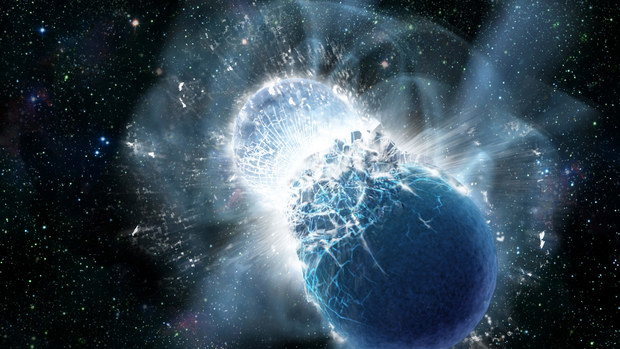You probably heard about this announcement from LIGO yesterday, but I thought I should add some details, and shift the emphasis of the story to where it really belongs:
The previous detections of gravitational waves (GW) all originated from the merging of large black holes. Such mergers can produce relatively strong, but very brief GWs – just a small fraction of a second. And they produce nothing else – no light or other electromagnetic radiation. Therefore, these observations could not be confirmed by optical telescopes or other detectors.
In contrast, this event, dubbed “GW170817” because it was detected on Aug. 17th, 2017, lasted nearly 2 minutes, and the final collision produced a gamma ray burst (GRB) that was detected less than 2 seconds later by the Fermi gamma ray space telescope. The GW was detected by both of the LIGO detectors, plus the Virgo detector in Italy. However, the LIGO observatory in Livingston, Louisiana experienced a “glitch” during the event, which caused the system to automatically reject the detection, and it had to be manually extracted from the raw data, compensating for the glitch. Once the data from both LIGO sites and the Virgo observatory was processed and analyzed, the location of the Neutron Star collision was calculated and about 12 hours after the event, optical telescopes were able to see a residual bright spot in a galaxy know as NGC4993, some 130 million light-years from Earth.
So GW170817 was a first on several fronts:
- First GW detection with a corresponding GRB detection (from approximately the same direction)
- First GW detection with a corresponding optical observation (a bright spot that was not previously there)
- First GW detection of a neutron star collision – or anything other than a black hole merger
- First GW detection for the Virgo observatory
- First GW detected by 3 separate observatories
So what was reported on most news outlets? That collisions of neutron stars are thought to be how gold and some other precious metals are formed. OK, that’s interesting, but not really very important, and not something we learned from this event. GW detectors are a completely new way for us to observe the universe, and these observations are parallels to the first observations with visual telescopes, hundreds of years ago. More specifically, this event would be like the first multiple visual observations of a supernova in a distant galaxy. The instrument is proving itself to be a remarkable tool in our quest to better understand the universe, and the multiple, correlated observations provide enormous confidence in the accuracy of the observations. That’s worth more than all the gold in the world!
For more details, see the LIGO announcement: https://www.ligo.caltech.edu/news/ligo20171016
